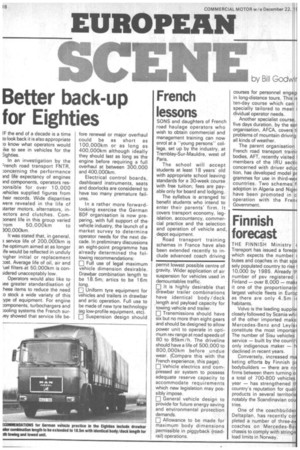Better back-up for Eighties
Page 20

If you've noticed an error in this article please click here to report it so we can fix it.
IF the end of a decade is a time to look back it is also appropriate :o know what operators would ike to see in vehicles for the Eighties.
In an investigation by the =Tench road transport FNTR, ;oncerning the performance ind life expectancy of engines Ind components, operators res )onsible for over 10,000 iehicles supplied figures from heir records. Wide disparities were revealed in the life of ;tarter motors, alternators, inectors and clutches. Corn )onent life in this group varied
TOM 50,000km to 300,000km.
It was stated that, in general, service life of 200,000km is :he optimum aimed at as longer
ife would be reflected in unduly ligher initial or replacement ..;ost. Average life of oil, air and filters at 50,000km is con;idered unacceptably low. Operators would also like to ;ee greater standardisation of .hese items to reduce the need
:o stock a wide variety of this :ype of equipment. For engine
:omponents, turbochargers and -cooling systems the French sur/ey showed that service life be
fore renewal or major overhaul could be as short as 100,000km or as long as 400,000km although ideally they should last as long as the engine before requiring a full overhaul at between 300,000 and 400,000km.
Electrical control boards, dashboard instruments, seats and doodocks are considered to have too many premature failures.
In a rather more forwardlooking exercise the German BDF organisation is now preparing, with full support of the vehicle industry, the launch of a market survey to determine operator needs for the next decade. In preliminary discussions an eight-point programme has already determined the following recommendations: ID Full use of legal maximum vehicle dimension desirable. Drawbar combination length to be 18.5m; artics to be 16m long.
Uniform tyre equipment for vehicles and trailers in drawbar and artic operation. Full use to be made of new tyre technology ,{eg low-profile equipment, etc). El Suspension design should permit lowest possible centre of gravity. Wider application of air suspension for vehicles used in demountables traffic.
ID It is highly desirable that drawbar trailer combinations have identical body /deck .length and payload capacity for towing vehicle and trailer.
E Transmissions should have six but no more than eight gears and should be designed to allow power unit to operate in optimum rev range at road speeds of 80 to 85km/h. The driveline should have a life of 500,000 to 800,000km before undue wear. (Compare this with the French experience, this page).
E Vehicle electrics and compressed air system to possess adequate reserve capacity to accommodate requirements which new legislation may possibly impose.
E General vehicle design to provide for future energy saving and environmental protection demands.
EI Allowance to be made for maximum body dimensions . permissible in piggyback (roadrail) operations.




















































































